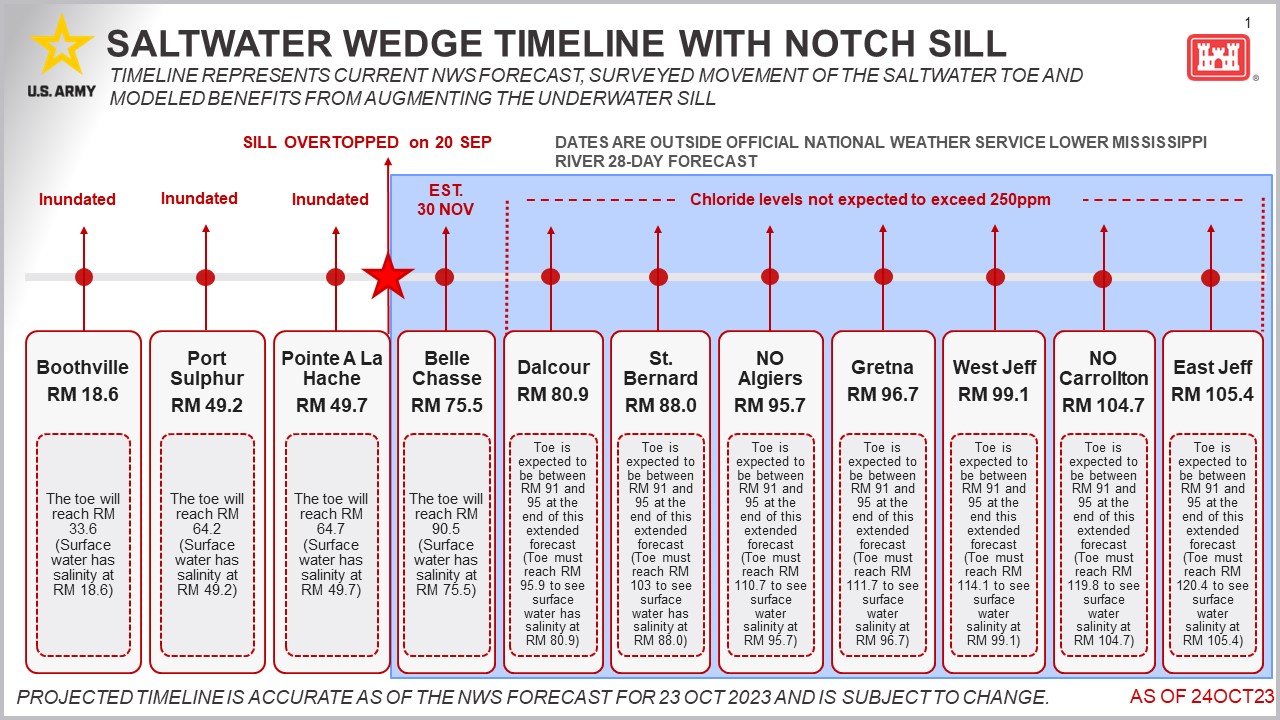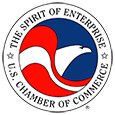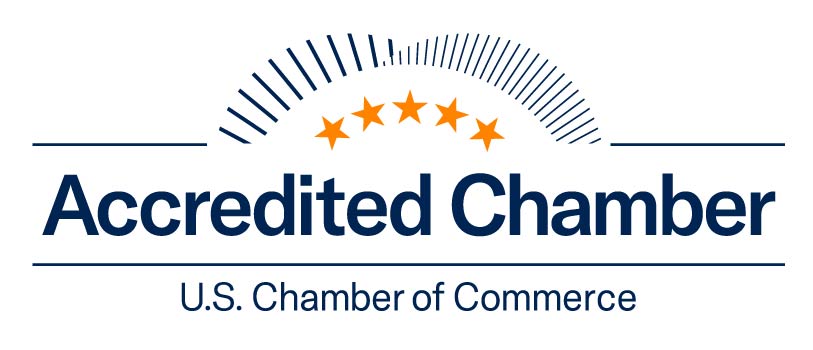Saltwater Intrusion Updates and Frequently Asked Questions for Business Owners
Last Updated: October 27, 2023
Updates:
The Jefferson Chamber continues to work with our partners at Jefferson Parish, GNO Inc., the Governor’s Office of Homeland Security and Emergency Preparedness (GOHSEP), and the U.S. Army Corps of Engineers to monitor the ongoing Lower Mississippi River Saltwater Intrusion Emergency. We will share updates as they become available.
For the latest on the saltwater wedge, you can visit the Jefferson Parish Saltwater Intrusion dashboard by clicking here. For additional information, visit www.emergency.la.gov. To stay updated, follow Jefferson Parish on Facebook, Twitter, Threads, YouTube, and Instagram (@JeffParishGov) or text JPALERT or JPNOTICIAS to 888-777.

Frequently Asked Questions:
When could Jefferson Parish and its municipalities be affected?
On Thursday, October 19, the U.S. Army Corps of Engineers (USACE) announced shared a new forecast showing delayed impacts at facilities upriver, but treatment facilities in Port Sulphur and Pointe A La Hache continue to experience impacts from saltwater intrusion.
Water intakes for all of St. Bernard, New Orleans and Jefferson Parish would not see concerning levels of salt water in the latest forecast.
USACE began barging water to the Port Sulphur and Pointe A La Hache treatment facilities to blend with water from the intakes to bring the chloride down to treatable levels. To date, USACE has delivered more than 37.8 million gallons of water. USACE has also mobilized Reverse Osmosis Units to support processing at water treatment facilities impacted by saltwater intrusion.
While this is positive news, Jefferson Parish successfully completed installation and testing of its West Bank flexible waterline system on Tuesday, October 24. Although saltwater entering the Mississippi River from the Gulf of Mexico is no longer forecast to reach Jefferson Parish’s three water intakes and threaten the drinking water supply, parish officials continued construction of a scaled-back system as a precautionary mitigation measure.
The Jefferson Parish Public Works Department and Water Department developed a multi-pronged plan of action, which resulted in the construction of a 15-mile flexible waterline system on the West Bank of Jefferson Parish that will allow fresh water to be pumped in from a location slightly upriver of Kenner. The completed system begins at the intake of the West Bank Water Treatment Plant, which produces 30 million gallons of water a day. If the USACE’s forecast changes for the worse, Jefferson Parish is prepared to install the complete system for the final eight miles.
Currently, the Chloride levels in Jefferson Parish are normal water levels that are safe to drink. The Louisiana Department of Health, in conjunction with the Jefferson Parish Water Department, will issue a public advisory if chloride levels rise above the drinking water standard of 250 parts per million.
How long will this be a problem?
The length of time is unknown, however, disruption will not occur from the presence of salt water alone. Once the presence of saltwater is detected, the salinity level of the water will determine what impacts will result.
Are there ways to stop or slow the saltwater from entering the Mississippi River?
Yes. Additional rainfall in the Mississippi River Valley has increased water flow in the river and pushed back the saltwater wedge. If drought conditions continue, the experts are exploring several options for bringing in fresh water, as well as filtration methods and systems that will diminish or alleviate the impact. As of October 5th, the impact to the Westbank would not occur until late November.
What plans are underway to stop or slow the saltwater from entering the Mississippi River?
The Governor’s Office, in coordination with the US Army Corps of Engineers, and other local, state, and federal officials are working to deploy a variety of strategies to stop or slow the saltwater wedge. A few options include:
• Sill – Construction of an underwater barrier, or sill, is ahead of schedule. The U.S. Army Corps of Engineers estimates that construction will be completed on October 15th. It is helping slow the saltwater as planned.
• Pipeline – Although reports from October 5th are encouraging, plans for a pipeline to bring in fresh water are moving forward to prepare us should current conditions change or if a drought occurs in the future.
• Blending – Bringing in fresh water from an alternate source, either by pumping fresh water via flexible pipe from fresh water sources or from upriver, or by barge or tanker ship, and mixing it with the salty river water to reduce the overall salt content. This is already being done in Plaquemines Parish.
• Desalination/Reverse Osmosis – Utilizing a process of converting saltwater to fresh water by filtering out the salt content by passing the water through a semi-permeable membrane that separates the water from any other molecules (salt, mineral content, impurities, etc.).
• Alternate Water Sources – Drawing from another source of fresh water further upriver and pumping it into the East Bank water systems of New Orleans and Jefferson Parish. This option will require a regional approach, including the participation of state and federal partners.
• Connections to Other Systems – It may be possible in some cases for one jurisdiction to connect their water system to that of another system further upriver beyond the location of the wedge, allowing them to draw fresh water from neighbors upriver for as long as possible.
At what level is it no longer safe to drink or cook with our water?
Higher salinity levels exceeding the U.S. Environmental Protection Agency’s maximum standard of 250 mg/L can impact infrastructure and water processing systems, as well as corrode industrial machinery and water distribution systems. In partnership with the Environmental Protection Agency (EPA), officials will issue an advisory if chloride levels reach 250 parts per million. Water in Jefferson Parish is safe for drinking, bathing, and cooking.
If water has salinity levels, is it safe to drink?
It depends. At low levels, healthy individuals can consume water with some salt content. Parish, State and Federal authorities conduct extensive testing of drinking water and are expanding upon that testing to provide even more comprehensive monitoring at this time. Should saline levels reach a level deemed to be unsafe they will advise citizens to shift all drinking water to bottled water until levels are returned to normal. Saltwater with certain saline content can make drinking water unsafe, especially for vulnerable people including but not limited to people with kidney disease or high blood pressure, people on a low-sodium diet, dialysis patients, infants, and pregnant women. Source: Louisiana Department of Health
If water has salinity levels, will it affect pipes or appliances in my home or business?
It is believed that exposure to saltwater over an extended period of time at high levels of salinity can cause damage to plumbing, appliances, cooling systems that use water, and water heaters. The best source of information for specific equipment under these conditions is the manufacturer, vendor and/or service provider.
From the U.S. Army Corps of Engineers:
The intrusion of salt water into the Mississippi river is a naturally occurring phenomenon because the bottom of the riverbed between Natchez, Miss., and the Gulf of Mexico is below sea level. Denser saltwater moves upriver along the bottom of the river beneath the less dense fresh water flowing downstream. Under normal conditions, the downstream flow of the river prevents significant upriver progression of the salt water. However, in times of extreme low volume water flow, such as what has been occurring this year, unimpeded salt water can travel upriver and threaten municipal drinking water and industrial water supplies. An underwater sill was constructed on four previous occasions in 1988, 1999, 2012 and last year in 2022.
Other Helpful Links:


